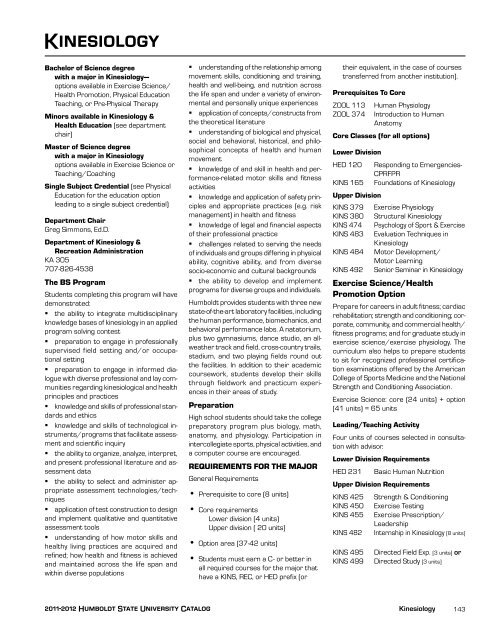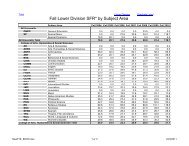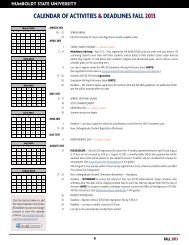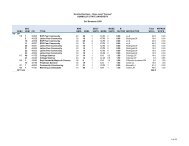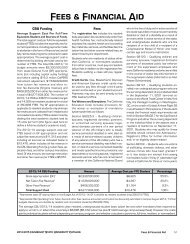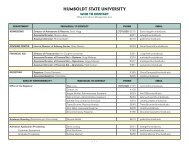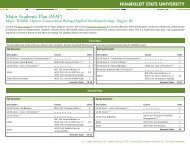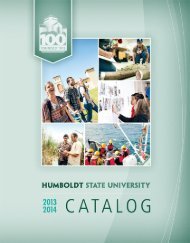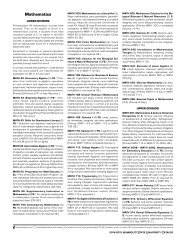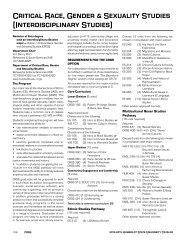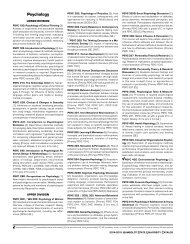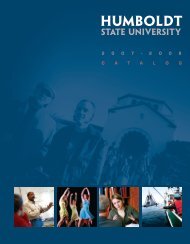2011-12 Academic Year - Bad Request - Humboldt State University
2011-12 Academic Year - Bad Request - Humboldt State University
2011-12 Academic Year - Bad Request - Humboldt State University
Create successful ePaper yourself
Turn your PDF publications into a flip-book with our unique Google optimized e-Paper software.
Kinesiology<br />
Bachelor of Science degree<br />
with a major in Kinesiology—<br />
options available in Exercise Science/<br />
Health Promotion, Physical Education<br />
Teaching, or Pre-Physical Therapy<br />
Minors available in Kinesiology &<br />
Health Education (see department<br />
chair)<br />
Master of Science degree<br />
with a major in Kinesiology<br />
options available in Exercise Science or<br />
Teaching/Coaching<br />
Single Subject Credential (see Physical<br />
Education for the education option<br />
leading to a single subject credential)<br />
Department Chair<br />
Greg Simmons, Ed.D.<br />
Department of Kinesiology &<br />
Recreation Administration<br />
KA 305<br />
707-826-4538<br />
The BS Program<br />
Students completing this program will have<br />
demonstrated:<br />
the ability to integrate multidisciplinary<br />
knowledge bases of kinesiology in an applied<br />
program solving contest<br />
preparation to engage in professionally<br />
supervised field setting and/or occupational<br />
setting<br />
preparation to engage in informed dialogue<br />
with diverse professional and lay communities<br />
regarding kinesiological and health<br />
principles and practices<br />
knowledge and skills of professional standards<br />
and ethics<br />
knowledge and skills of technological instruments/programs<br />
that facilitate assessment<br />
and scientific inquiry<br />
the ability to organize, analyze, interpret,<br />
and present professional literature and assessment<br />
data<br />
the ability to select and administer appropriate<br />
assessment technologies/techniques<br />
application of test construction to design<br />
and implement qualitative and quantitative<br />
assessment tools<br />
understanding of how motor skills and<br />
healthy living practices are acquired and<br />
refined; how health and fitness is achieved<br />
and maintained across the life span and<br />
within diverse populations<br />
understanding of the relationship among<br />
movement skills, conditioning and training,<br />
health and well-being, and nutrition across<br />
the life span and under a variety of environmental<br />
and personally unique experiences<br />
application of concepts/constructs from<br />
the theoretical literature<br />
understanding of biological and physical,<br />
social and behavioral, historical, and philosophical<br />
concepts of health and human<br />
movement<br />
knowledge of and skill in health and performance-related<br />
motor skills and fitness<br />
activities<br />
knowledge and application of safety principles<br />
and appropriate practices (e.g. risk<br />
management) in health and fitness<br />
knowledge of legal and financial aspects<br />
of their professional practice<br />
challenges related to serving the needs<br />
of individuals and groups differing in physical<br />
ability, cognitive ability, and from diverse<br />
socio-economic and cultural backgrounds<br />
the ability to develop and implement<br />
programs for diverse groups and individuals.<br />
<strong>Humboldt</strong> provides students with three new<br />
state-of-the-art laboratory facilities, including<br />
the human per form ance, biomechanics, and<br />
behavioral performance labs. A natatorium,<br />
plus two gym nasi ums, dance studio, an allweather<br />
track and field, cross-coun try trails,<br />
stadium, and two playing fields round out<br />
the facilities. In addition to their academic<br />
coursework, students develop their skills<br />
through fieldwork and practicum experiences<br />
in their areas of study.<br />
Preparation<br />
High school students should take the college<br />
prep ara tory program plus biology, math ,<br />
anat o my, and physiology. Participation in<br />
intercollegiate sports, physical activities, and<br />
a computer course are encouraged.<br />
REQUIREMENTS FOR THE MAJOR<br />
General Requirements<br />
• Prerequisite to core (8 units)<br />
• Core requirements<br />
Lower division (4 units)<br />
Upper division ( 20 units)<br />
• Option area (37-42 units)<br />
• Students must earn a C- or better in<br />
all required courses for the major that<br />
have a KINS, REC, or HED prefix (or<br />
their equivalent, in the case of courses<br />
transferred from another institution).<br />
Prerequisites To Core<br />
ZOOL 113 Human Physiology<br />
ZOOL 374 Introduction to Human<br />
Anatomy<br />
Core Classes (for all options)<br />
Lower Division<br />
HED <strong>12</strong>0 Responding to Emergencies-<br />
CPRFPR<br />
KINS 165 Foundations of Kinesiology<br />
Upper Division<br />
KINS 379 Exercise Physiology<br />
KINS 380 Structural Kinesiology<br />
KINS 474 Psychology of Sport & Exercise<br />
KINS 483 Evaluation Techniques in<br />
Kinesiology<br />
KINS 484 Motor Development/<br />
Motor Learning<br />
KINS 492 Senior Seminar in Kinesiology<br />
Exercise Science/Health<br />
Promotion Option<br />
Prepare for careers in adult fitness; cardiac<br />
rehabilitation; strength and conditioning; corporate,<br />
community, and commercial health/<br />
fitness programs; and for graduate study in<br />
exercise science/exercise physiology. The<br />
curriculum also helps to prepare students<br />
to sit for recognized professional certification<br />
examinations offered by the American<br />
College of Sports Medicine and the National<br />
Strength and Conditioning Association.<br />
Exercise Science: core (24 units) + option<br />
(41 units) = 65 units<br />
Leading/Teaching Activity<br />
Four units of courses selected in consultation<br />
with advisor.<br />
Lower Division Requirements<br />
HED 231 Basic Human Nutrition<br />
Upper Division Requirements<br />
KINS 425 Strength & Conditioning<br />
KINS 450 Exercise Testing<br />
KINS 455 Exercise Prescription/<br />
Leadership<br />
KINS 482 Internship in Kinesiology [8 units]<br />
KINS 495 Directed Field Exp. [3 units] or<br />
KINS 499 Directed Study [3 units]<br />
<strong>2011</strong>-20<strong>12</strong> <strong>Humboldt</strong> <strong>State</strong> <strong>University</strong> Catalog Kinesiology<br />
143


